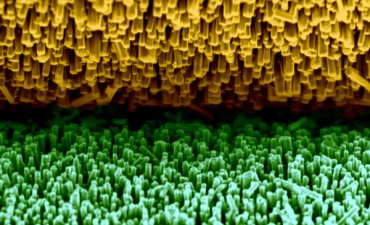
‘Power dressing’ could take on an entirely new meaning thanks to novel energy-scavenging textile fibres created by researchers at the Georgia Institute of Technology in the US. They claim that a pair of trousers worn by a hiker or a tent fluttering in the breeze could generate enough electricity to charge a mobile phone, if they were made from fabric woven from the fibres.
The fibres consist of millions of 100 nm-diameter zinc oxide nanowires grown on the surface of much larger Kevlar strands. The nanowires are about 3.5 µm long and radiate outwards from the surface of the Kevlar, which can then be twisted together to create thicker fibres and ultimately woven to make a durable fabric.
Piezoelectric material
When such a fabric is stretched, crumpled or otherwise disturbed, the nanowires would rub against each other and bend. Because zinc oxide is a piezoelectric material, this bending causes several millivolts to develop along the nanowire.
According to Georgia Tech’s Zhong Lin Wang, who led the project, the key challenge in designing fibres for such a “piezotronic” material is how to extract tiny amounts of electricity from lots and lots of nanowires (Nature 451 809).
Twisted pair
To prove that they could do this, the team coated one Kevlar-nanowire strand with gold and twisted it around a second bare Kevlar-nanowire strand. Since gold is a good conductor and zinc oxide a semiconductor, a Schottky barrier is formed where the nanowires touch. This means that current can flow in one direction across this barrier allowing an electrical circuit to be made and electrical energy extracted from the bare nanowires.
The team connected an ammeter between the gold and bare strands and the entwined strands were flexed so that one strand rubbed against the other. For entwined strands several millimetres long, Wang and colleagues measured a peak current of about 4 nA. The team estimate that a fabric made of the material would contain millions of such strands and that it could generate as much as 80 mW per square metre. However, Wang cautioned that connecting up all these strands to extract a useful amount of energy remains a significant challenge.
Wind energy
According to Wang, such a fabric would be strong and light weight and several layers could be designed into a garment that could power a portable electronic device or charge a mobile phone from the wearer’s movements. It could also be incorporated into tents, curtains or flags that could harvest energy from the wind.
Wang has applied for several patents and has just set up a company called Nanopiezotronics to commercialize the technology. While he wouldn’t say how much it would cost to make his fabric, it is likely to be expensive and as a result Wang believes that the military will be the first to use the technology.



